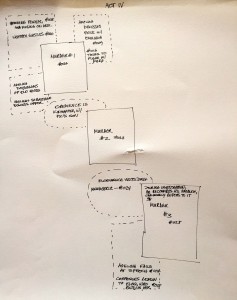Jemina noticed the Very Small Person the moment she entered the train.The child paused in the doorway to survey the car before glancing down at her ticket and then at the other half of the hard wooden bench, high-backed, its shellac peeling, that Jemina sat on. Jemina tucked the macrame bag beside her in with her elbow.
The child was one of the last on, which was why Jemina had been hoping against hope to have the bench to herself, at least all the two day trip to Kansas city. The train began to roll forward, a hoot of steam from the engine, a bell clang from the caboose at the back of the train, the rumble underfoot making the little girl pick her way with extra caution, balancing the small black suitcase in one hand against the pillowy cloth bag in the other.
She arrived mid-car beside Jemina and nodded at her as she struggled briefly to hoist her suitcase up before the elderly man across the man did it for her. She plumped the cloth bag in the corner between sidearm and back and sat down with a little noise of delight as she looked around. Catching herself at the noise, she blushed, fixed her gaze sternly forward as she folded her hands in her lap, and peeped at Jemina sidelong.
Jemina tried to imagine how she might appear. She knew herself thin but nicely dressed and pale-skinned. The lace at her throat was Bruges, the cross around her neck gold. She looked like a school-teacher, she imagined, and not a particularly nice one. She felt her lips thin further at the thought.
The child, interpreting the flattening of Jemina’s mouth for disapproval, fished in her bag and took out a small blackbound Bible. She began to read.
“Oh, it’s all right,” Jemina said. Her boldness surprised her, but this was a child, after all. “I’m Jemina Iarainn and I’m a scientist, headed to work at the War Institute in Seattle. Who are you are where are you going?”
The smile bestowed on her could have lit a room. The Bible slid back into the bag. “Oh thank goodness! I’m Laurel Finch and this is my very first train ride ever, up to Seattle too, and I was hoping I’d have an agreeable companion on my voyage.”
She stumbled a little over the solemnity in the last words. Jemina said, “Trips are much, much nicer with someone to talk to. Where are you going in Seattle? To visit relatives?”
“To the Soldiers’ Orphans’ Home there,” Laurel said, and her mouth drooped before she summoned her smile again. “I’ve been staying with my uncle for the last three years but he is traveling to China as an ambassador. It’s all right, he’ll come back for me, but in the meantime I’m to live there for a few years.”
“Seattle is very nice,” Jemina said. Her mind raced along the years before this child, living among orphans with no chance of adoption herself. Bleak, as bleak as any of Jemina’s childhood years. “You will meet Princess Angeline, Chief Seattle’s daughter. She lives down near the market and is a real Indian princess.”
“Do you know Seattle well?”
Jemina shook her head, then nodded. “My twin sister is out there already and she has been writing me long letters.”
“Is she also a scientist?”
“She writes for the newspaper.”
“Oh! Like Nellie Bly!” Laurel clapped her hands and Jemina sighed internally. A daredevil reporter was more exciting than a scientist, but she was the one constructing giant killing war machines, after all, even though she was not at liberty to talk about any of that.






5 Responses
Cat –
(You may remember me as the grey ponytailed newbie at your Penguicon 2011 workshop.)
Congratulations on your output for 2011, and best of luck on the upcoming awards. Since I am afflicted by the curse of statistics, I was wondering if you would answer these questions – I’m trying to get some idea how hard you worked to get those 19 publications, and what the typical life cycle of one of your stories is:
Writing –
How many stories did you start in 2011?
How many did you finish (1st draft quality, at least)?
How many did you finish (ready for submission)?
Publishing –
How many stories did you submit in 2011?
How many stories written entirely in 2011 did you submit?
What was the highest number of submissions for a single story (i.e., # of rejections +1, I assume 😛 )?
If this is too nosy, please feel free to ignore or delete. Thank you.
– JDB
I’m going to go through my spreadsheet and see if I can answer this in an accurate way. I track submissions, but not when stories are written, usually. Hey, see you at Confusion this weekend?
Ouch! “Funny how the time flies when you’re being had.” I hadn’t realized it was this weekend, and had already made other plans.
Maybe next year….
Ah, poop! I should be there next year too, I really enjoy the con.
I just blogged with the stats – but I dunno how many stories I started. 🙂 Lots.